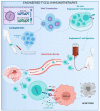Against the Resilience of High-Grade Gliomas: The Immunotherapeutic Approach (Part I)
- PMID: 33803885
- PMCID: PMC8003180
- DOI: 10.3390/brainsci11030386
Against the Resilience of High-Grade Gliomas: The Immunotherapeutic Approach (Part I)
Abstract
The resilience of high-grade gliomas (HGGs) against conventional chemotherapies is due to their heterogeneous genetic landscape, adaptive phenotypic changes, and immune escape mechanisms. Innovative immunotherapies have been developed to counteract the immunosuppressive capability of gliomas. Nevertheless, further research is needed to assess the efficacy of the immuno-based approach. The aim of this study is to review the newest immunotherapeutic approaches for glioma, focusing on the drug types, mechanisms of action, clinical pieces of evidence, and future challenges. A PRISMA (Preferred Reporting Items for Systematic Review and Meta-Analysis)-based literature search was performed on PubMed/Medline and ClinicalTrials.gov databases using the keywords "active/adoptive immunotherapy," "monoclonal antibodies," "vaccine," and "engineered T cell.", combined with "malignant brain tumor", "high-grade glioma." Only articles written in English published in the last 10 years were selected, filtered based on best relevance. Active immunotherapies include systemic temozolomide, monoclonal antibodies, and vaccines. In several preclinical and clinical trials, adoptive immunotherapies, including T, natural killer, and natural killer T engineered cells, have been shown to be potential treatment options for relapsing gliomas. Systemic temozolomide is considered the backbone for newly diagnosed HGGs. Bevacizumab and rindopepimut are promising second-line treatments. Adoptive immunotherapies have been proven for relapsing tumors, but further evidence is needed.
Keywords: CAR T cell; bevacizumab; cell-based therapy; glioblastoma; immunotherapy; malignant brain tumor; temozolomide.
Conflict of interest statement
The authors declare no conflict of interest.
Figures





Similar articles
-
Against the Resilience of High-Grade Gliomas: Gene Therapies (Part II).Brain Sci. 2021 Jul 23;11(8):976. doi: 10.3390/brainsci11080976. Brain Sci. 2021. PMID: 34439595 Free PMC article. Review.
-
Innovative therapies for malignant brain tumors: the road to a tailored cure.Acta Biomed. 2020 Jun 30;91(7-S):5-17. doi: 10.23750/abm.v91i7-S.9951. Acta Biomed. 2020. PMID: 32608372 Free PMC article.
-
Emerging immune-based technologies for high-grade gliomas.Expert Rev Anticancer Ther. 2022 Sep;22(9):957-980. doi: 10.1080/14737140.2022.2110072. Epub 2022 Aug 12. Expert Rev Anticancer Ther. 2022. PMID: 35924820 Review.
-
Adoptive immunotherapies in neuro-oncology: classification, recent advances, and translational challenges.Acta Biomed. 2020 Jun 30;91(7-S):18-31. doi: 10.23750/abm.v91i7-S.9952. Acta Biomed. 2020. PMID: 32608373 Free PMC article.
-
Immunotherapy for High-Grade Gliomas.Cancers (Basel). 2025 May 31;17(11):1849. doi: 10.3390/cancers17111849. Cancers (Basel). 2025. PMID: 40507329 Free PMC article. Review.
Cited by
-
Against the Resilience of High-Grade Gliomas: Gene Therapies (Part II).Brain Sci. 2021 Jul 23;11(8):976. doi: 10.3390/brainsci11080976. Brain Sci. 2021. PMID: 34439595 Free PMC article. Review.
-
An Overview of The Role of Tumor Necrosis Factor-Alpha in Epileptogenesis and Its Terapeutic Implications.Acta Biomed. 2022 Mar 21;92(S4):e2021418. doi: 10.23750/abm.v92iS4.12667. Acta Biomed. 2022. PMID: 35441606 Free PMC article.
-
Gene Polymorphisms Increasing the Risk of Intracranial Aneurysms: Interleukin-6 -174G>C and -572G>C (Part II).Acta Biomed. 2022 Mar 21;92(S4):e2021420. doi: 10.23750/abm.v92iS4.12669. Acta Biomed. 2022. PMID: 35441611 Free PMC article.
-
Advances in NK cell therapy for brain tumors.NPJ Precis Oncol. 2023 Feb 15;7(1):17. doi: 10.1038/s41698-023-00356-1. NPJ Precis Oncol. 2023. PMID: 36792722 Free PMC article. Review.
-
Pericytes Are Immunoregulatory Cells in Glioma Genesis and Progression.Int J Mol Sci. 2024 May 7;25(10):5072. doi: 10.3390/ijms25105072. Int J Mol Sci. 2024. PMID: 38791110 Free PMC article. Review.
References
-
- Ostrom Q.T., Gittleman H., Liao P., Rouse C., Chen Y., Dowling J., Wolinsky Y., Kruchko C., Barnholtz-Sloan J. CBTRUS Statistical Report: Primary Brain and Central Nervous System Tumors Diagnosed in the United States in 2007–2011. Neuro-Oncology. 2014;16:iv1–iv63. doi: 10.1093/neuonc/nou223. - DOI - PMC - PubMed
Publication types
LinkOut - more resources
Full Text Sources
Other Literature Sources

